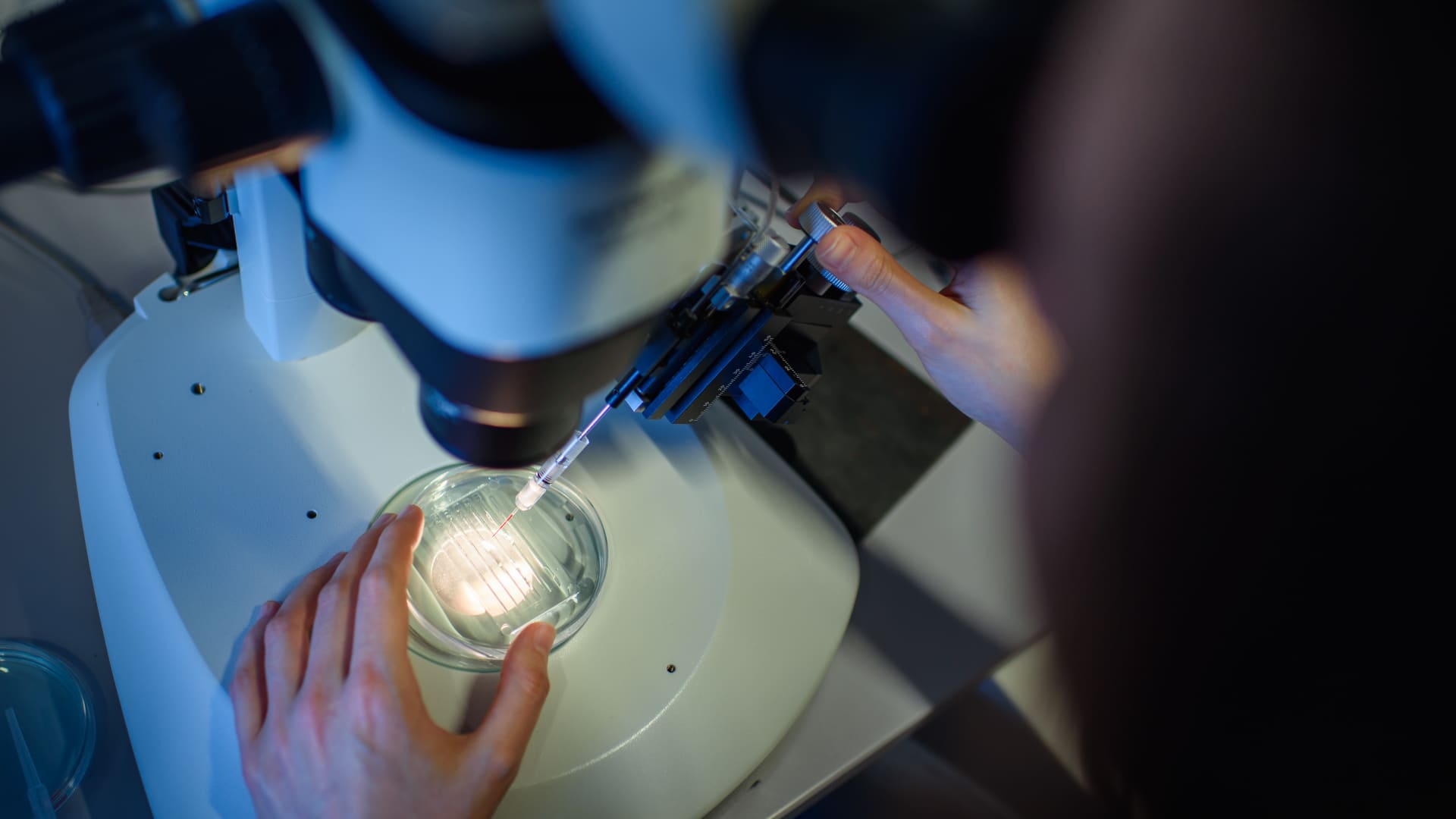

At age 19, Joe Tsogbe underwent his first hip replacement. In his 20s, he averaged about nine hospitalizations a year. By his 30s, that rose to more than a dozen.
All the result of sickle cell disease, an inherited blood disorder where a genetic mutation causes normally full-moon shaped red blood cells to form into half moons and get stuck inside blood vessels, restricting blood flow and causing bouts of excruciating pain.
The disease affects about 100,000 people in the U.S., many of whom are Black. Few treatments are available, and the only cure is a bone marrow transplant where a patient receives healthy blood stem cells from a donor. New genetic treatments aim to offer relief while eliminating the need to track down donors.
Tsogbe, now 37, received one of those options, known as exa-cel and co-developed by Vertex Pharmaceuticals and CRISPR Therapeutics, via a clinical trial in 2021. The treatment uses Nobel Prize-winning technology called CRISPR to edit a person’s DNA and alleviate the symptoms of sickle cell disease.
U.S. regulators are expected to approve exa-cel for use in sickle cell patients by the end of this week. The U.K. approved it under the brand name Casgevy last month.
Regulators in the U.S. are also reviewing another gene therapy from Bluebird Bio called lovo-cel. It works differently than exa-cel but is administered similarly and is also intended to eliminate pain crises. It’s expected to be approved later this month.
Approval of exa-cel by the U.S. Food and Drug Administration would mark a scientific milestone about a decade after the discovery of CRISPR and a breakthrough for patients desperate for a better option.
It could also present a major test for the American health-care system, with Wall Street eyeing a price tag of around $2 million per patient. Tens of thousands of people could be eligible.
First-of-its-kind treatment
In 2012, researchers Jennifer Doudna and Emmanuelle Charpentier published their seminal paper on a system for editing genes called CRISPR-Cas9. The finding sparked a rush of companies seeking to leverage that insight to treat various diseases.
Sickle cell emerged as a prime target.
Scientist Linus Pauling described sickle cell as the first molecular disease in 1949. The disorder is most common in Africa, where the sickle cell gene helped protect against malaria. People with one copy of the mutation usually don’t have any symptoms of the disease, while people with two copies – one from each parent – can develop severe complications.
One edit to a patient’s genes via CRISPR technology could turn on what’s called fetal hemoglobin, a protein that normally shuts off shortly after birth, to help red blood cells keep their healthy shape. And the work could be done in a lab: Blood stem cells are extracted, edited and then infused back into the patient’s blood stream.
“We are more or less training the cells to express and to produce more of this fetal hemoglobin,” said Dr. Markus Mapara, director of blood and marrow transplantation at NewYork-Presbyterian/Columbia University Irving Medical Center, who treated patients in the exa-cel trials.
While the treatment itself is administered just once, the whole process takes months.
Blood stem cells are extracted and isolated before being sent to Vertex’s lab, where they’re genetically modified. Once ready, patients receive chemotherapy for a few days to clear out the old cells and make room for the new ones. After the new cells are infused, recipients spend weeks in the hospital recovering.
A researcher watches the CRISPR/Cas9 process through a stereomicroscope at the Max-Delbrueck-Centre for Molecular Medicine.
picture alliance | picture alliance | Getty Images
Vertex and CRISPR made a pact in 2015 to co-develop gene-editing treatments for genetic diseases, including sickle cell. As part of the deal, Vertex will take the lead on launching exa-cel, pending approval.
Vertex sees exa-cel as a multibillion-dollar opportunity. The company plans to focus on the roughly 32,000 people in the U.S. and Europe with the most severe forms of the disease, like Tsogbe.
Vertex is also seeking approval to use exa-cel for treat another blood disorder called beta thalassemia. That FDA decision is slated for March.
Yet Wall Street is skeptical exa-cel will be big business. Analysts see $1.2 billion in exa-cel sales for Vertex in 2028, a sliver of the $14 billion in revenue they’re projecting for the whole company that year, according to FactSet.
The cost of a possible cure
While Mapara said it’s too soon to call exa-cel a cure, he shows prospective patients charts from clinical trials displaying how many pain crises people experienced before and after the treatment. For most participants, the new number is zero.
“It’s mind-blowing,” said Mapara, who is a paid consultant for Vertex and CRISPR. “You really see how effective this treatment has really been.”
But the lengthy timeline for the treatment, along with the risk of chemotherapy-induced infertility, could make exa-cel a difficult option for some patients. Plus, it would only be available at a limited number of specialized health-care facilities, which could further curb availability. And then there’s the cost.
Wall Street expects Vertex to charge about $2 million per patient for the treatment. That wouldn’t make exa-cel the most expensive gene therapy, with recently approved treatments exceeding $3 million per person. But it could be made available to tens of thousands more patients than other gene therapies, a factor that could make insurers more reluctant to widely cover it.
For Tsogbe, any price is worth it.
Joe Tsogbe with his mother. Tsogbe received exa-cel, a gene-editing treatment for sickle cell disease, in 2021.
Credit: Joe Tsogbe
As a baby in the West African country of Togo, Tsogbe cried while his fingers, toes, knees and other joints swelled. His mother took him to multiple doctors until a specialist diagnosed Tsogbe with sickle cell disease. At the time, there weren’t many available treatments.
But Tsogbe promised his mother that he would travel to the United States and find a cure for sickle cell so he wouldn’t be sick anymore. He moved to the U.S. at age 16 and eventually found the exa-cel trial.
He hasn’t experienced a pain crisis since receiving the treatment about two years ago. It hasn’t erased the damage his body had already accumulated, nor has it completely eliminated the aches and pains. But it’s kept him out of the hospital, and he’s busier than ever. He runs two entertainment companies and teaches dance, activities he’s always loved but that previously left him drained.
Last year, he went back to Togo to visit his mother for the first time since he left in 2003 as, in his words, a totally different person.
“In a way I kept my promise,” Tsogbe said.
— CNBC’s Patrick Manning contributed to this report.







